The Cell Surface Markers Detection Market is estimated to be valued at USD 6.2 billion in 2025 and is projected to reach USD 13.8 billion by 2035, registering a compound annual growth rate (CAGR) of 8.4% over the forecast period.
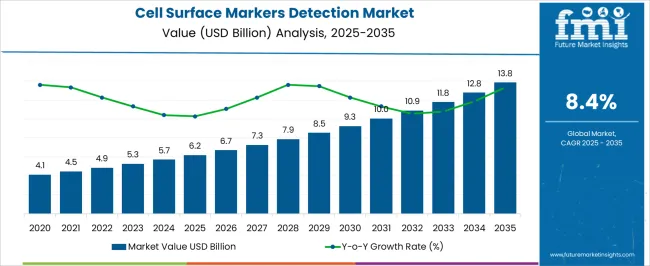
| Metric | Value |
|---|---|
| Cell Surface Markers Detection Market Estimated Value in (2025 E) | USD 6.2 billion |
| Cell Surface Markers Detection Market Forecast Value in (2035 F) | USD 13.8 billion |
| Forecast CAGR (2025 to 2035) | 8.4% |
The Cell Surface Markers Detection market is witnessing steady growth, supported by the rising demand for precision medicine, advancements in immunology research, and the increasing prevalence of chronic and infectious diseases. Cell surface markers play a critical role in identifying and characterizing cell types, making them indispensable in clinical diagnostics, drug discovery, and disease monitoring. Rapid adoption of advanced detection technologies such as flow cytometry, immunofluorescence, and molecular assays is driving efficiency and accuracy in research and healthcare applications.
Rising investments in biotechnology and life sciences, coupled with supportive government funding for cancer and infectious disease research, are expanding market opportunities. Integration of AI and automation in marker detection platforms is further reducing turnaround time and improving reproducibility.
Growing applications in immuno-oncology, stem cell research, and personalized treatment strategies are shaping the future trajectory of the market As healthcare systems worldwide continue to focus on early diagnosis, targeted therapies, and advanced monitoring tools, the Cell Surface Markers Detection market is expected to expand significantly, offering reliable solutions to both clinical and research communities.
The cell surface markers detection market is segmented by instrument and reagents types, application, and geographic regions. By instrument and reagents types, cell surface markers detection market is divided into Flow Cytometry, Hematology Analyzers, and Reagents & Kits. In terms of application, cell surface markers detection market is classified into Disease Diagnosis, Diseases Identification, Research For Drug Discovery, and Cytological Academic Research. Regionally, the cell surface markers detection industry is classified into North America, Latin America, Western Europe, Eastern Europe, Balkan & Baltic Countries, Russia & Belarus, Central Asia, East Asia, South Asia & Pacific, and the Middle East & Africa.
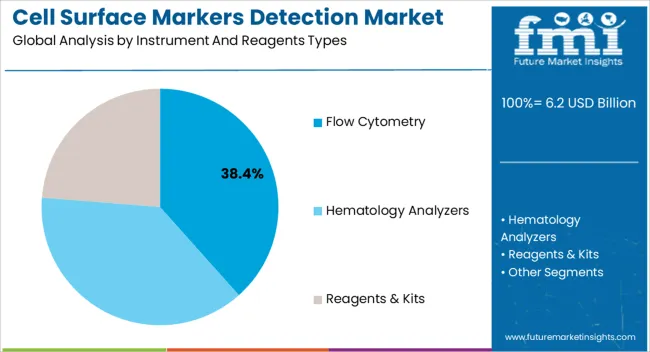
The flow cytometry segment is projected to hold 38.4% of the market revenue share in 2025, making it the leading instrument and reagents type. Its leadership is being driven by the technology’s ability to analyze multiple parameters of individual cells in real time, providing highly accurate and comprehensive results. Flow cytometry is widely used in immunophenotyping, cancer diagnostics, and stem cell analysis due to its capacity to detect and quantify complex cell populations.
Continuous improvements in instrument design, software algorithms, and reagent kits are enhancing data accuracy and user experience, further strengthening adoption across laboratories and hospitals. Additionally, advancements in portable and high-throughput cytometry systems are expanding accessibility and reducing costs for healthcare institutions.
Integration of automation and digital analysis tools allows for efficient sample processing and improved reproducibility, which are critical for clinical applications As the demand for rapid, high-quality diagnostic solutions continues to rise, flow cytometry is expected to retain its dominant position, supported by its versatility, proven reliability, and strong application base.
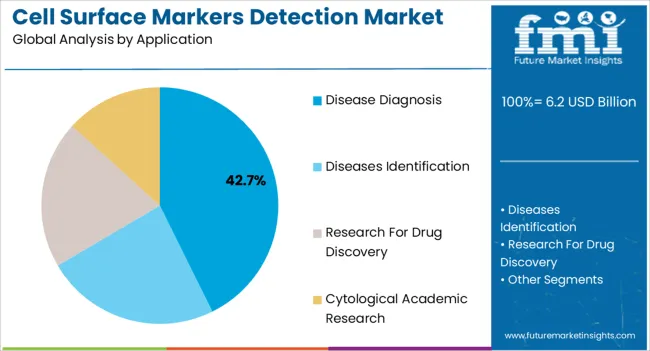
The disease diagnosis application segment is anticipated to account for 42.7% of the market revenue share in 2025, establishing it as the leading application area. Its dominance is being reinforced by the rising global burden of cancer, infectious diseases, and autoimmune disorders, where early and precise detection is essential for effective treatment outcomes. Cell surface markers are increasingly being used as diagnostic indicators in hematological malignancies, viral infections, and cardiovascular conditions, enabling clinicians to develop targeted therapies and monitor disease progression.
The demand for advanced diagnostic tools is further driven by the growth of personalized medicine and the rising emphasis on patient-specific treatment strategies. Continuous innovation in detection methods, coupled with the integration of AI-based analysis, is enhancing diagnostic accuracy and reducing turnaround time.
Governments and healthcare organizations are investing in advanced diagnostic infrastructure, further expanding adoption As disease prevalence rises and the need for cost-effective yet precise diagnostic solutions grows, the disease diagnosis segment is expected to remain a cornerstone of the market, contributing significantly to long-term growth.
Cell surface markers are also known as cell surface antigen serves as monograms to help identify and classify cells. The proteins expressed on the surface of cells often conveniently serve as markers of specific cell types. Even in the different types of cells there are specific combination of markers or antigens.
These molecules identification helps in disease diagnoses, to find the direct treatment for the disease, drug discovery and many more. Cell markers also assists in the determination of cell type expression of specific receptors vital for biological response.
It can be useful even in personalized medicine where it can help the physician to decide the effective therapy to be used for the patient by analyzing and understanding the cells isolated from patients.
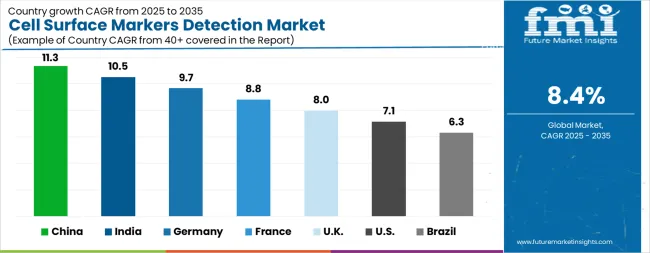
| Country | CAGR |
|---|---|
| China | 11.3% |
| India | 10.5% |
| Germany | 9.7% |
| France | 8.8% |
| UK | 8.0% |
| USA | 7.1% |
| Brazil | 6.3% |
The Cell Surface Markers Detection Market is expected to register a CAGR of 8.4% during the forecast period, exhibiting varied country level momentum. China leads with the highest CAGR of 11.3%, followed by India at 10.5%. Developed markets such as Germany, France, and the UK continue to expand steadily, while the USA is likely to grow at consistent rates. Brazil posts the lowest CAGR at 6.3%, yet still underscores a broadly positive trajectory for the global Cell Surface Markers Detection Market. In 2024, Germany held a dominant revenue in the Western Europe market and is expected to grow with a CAGR of 9.7%. The USA Cell Surface Markers Detection Market is estimated to be valued at USD 2.1 billion in 2025 and is anticipated to reach a valuation of USD 4.3 billion by 2035. Sales are projected to rise at a CAGR of 7.1% over the forecast period between 2025 and 2035. While Japan and South Korea markets are estimated to be valued at USD 305.5 million and USD 194.9 million respectively in 2025.
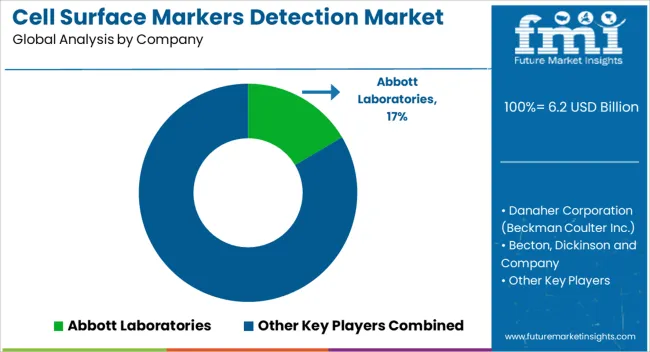
| Item | Value |
|---|---|
| Quantitative Units | USD 6.2 Billion |
| Instrument And Reagents Types | Flow Cytometry, Hematology Analyzers, and Reagents & Kits |
| Application | Disease Diagnosis, Diseases Identification, Research For Drug Discovery, and Cytological Academic Research |
| Regions Covered | North America, Europe, Asia-Pacific, Latin America, Middle East & Africa |
| Country Covered | United States, Canada, Germany, France, United Kingdom, China, Japan, India, Brazil, South Africa |
| Key Companies Profiled | Abbott Laboratories, Danaher Corporation (Beckman Coulter Inc.), Becton, Dickinson and Company, Bio Rad Laboratories Inc., F. Hoffmann-La Roche Ltd, Diasorin SpA (Luminex Corporation), Nihon Kohden Corporation, Qiagen NV, Siemens Healthineers, and Thermo Fisher Scientific Inc. |
The global cell surface markers detection market is estimated to be valued at USD 6.2 billion in 2025.
The market size for the cell surface markers detection market is projected to reach USD 13.8 billion by 2035.
The cell surface markers detection market is expected to grow at a 8.4% CAGR between 2025 and 2035.
The key product types in cell surface markers detection market are flow cytometry, hematology analyzers and reagents & kits.
In terms of application, disease diagnosis segment to command 42.7% share in the cell surface markers detection market in 2025.






Our Research Products

The "Full Research Suite" delivers actionable market intel, deep dives on markets or technologies, so clients act faster, cut risk, and unlock growth.

The Leaderboard benchmarks and ranks top vendors, classifying them as Established Leaders, Leading Challengers, or Disruptors & Challengers.

Locates where complements amplify value and substitutes erode it, forecasting net impact by horizon

We deliver granular, decision-grade intel: market sizing, 5-year forecasts, pricing, adoption, usage, revenue, and operational KPIs—plus competitor tracking, regulation, and value chains—across 60 countries broadly.

Spot the shifts before they hit your P&L. We track inflection points, adoption curves, pricing moves, and ecosystem plays to show where demand is heading, why it is changing, and what to do next across high-growth markets and disruptive tech

Real-time reads of user behavior. We track shifting priorities, perceptions of today’s and next-gen services, and provider experience, then pace how fast tech moves from trial to adoption, blending buyer, consumer, and channel inputs with social signals (#WhySwitch, #UX).

Partner with our analyst team to build a custom report designed around your business priorities. From analysing market trends to assessing competitors or crafting bespoke datasets, we tailor insights to your needs.
Supplier Intelligence
Discovery & Profiling
Capacity & Footprint
Performance & Risk
Compliance & Governance
Commercial Readiness
Who Supplies Whom
Scorecards & Shortlists
Playbooks & Docs
Category Intelligence
Definition & Scope
Demand & Use Cases
Cost Drivers
Market Structure
Supply Chain Map
Trade & Policy
Operating Norms
Deliverables
Buyer Intelligence
Account Basics
Spend & Scope
Procurement Model
Vendor Requirements
Terms & Policies
Entry Strategy
Pain Points & Triggers
Outputs
Pricing Analysis
Benchmarks
Trends
Should-Cost
Indexation
Landed Cost
Commercial Terms
Deliverables
Brand Analysis
Positioning & Value Prop
Share & Presence
Customer Evidence
Go-to-Market
Digital & Reputation
Compliance & Trust
KPIs & Gaps
Outputs
Full Research Suite comprises of:
Market outlook & trends analysis
Interviews & case studies
Strategic recommendations
Vendor profiles & capabilities analysis
5-year forecasts
8 regions and 60+ country-level data splits
Market segment data splits
12 months of continuous data updates
DELIVERED AS:
PDF EXCEL ONLINE
Live Cell RNA Detection Market Size and Share Forecast Outlook 2025 to 2035
Molecular Biomarkers For Cancer Detection Market Size and Share Forecast Outlook 2025 to 2035
Surface Contact Wire Rope Market Size and Share Forecast Outlook 2025 to 2035
Surface Water Sports Equipment Market Size and Share Forecast Outlook 2025 to 2035
Cellulose Diacetate Film Market Size and Share Forecast Outlook 2025 to 2035
Surface Protection Service Market Size and Share Forecast Outlook 2025 to 2035
Surface Protection Film Market Forecast and Outlook 2025 to 2035
Cellulose Fiber Market Forecast and Outlook 2025 to 2035
Cellulite Treatment Market Size and Share Forecast Outlook 2025 to 2035
Cellulose Derivative Market Size and Share Forecast Outlook 2025 to 2035
Cellulose Film Packaging Market Size and Share Forecast Outlook 2025 to 2035
Surface printed Film Market Size and Share Forecast Outlook 2025 to 2035
Cell Therapy Systems Market Size and Share Forecast Outlook 2025 to 2035
Cellular IoT Market Size and Share Forecast Outlook 2025 to 2035
Cell Isolation Market Size and Share Forecast Outlook 2025 to 2035
Cellulose Ether and Derivatives Market Size and Share Forecast Outlook 2025 to 2035
Cellular Push-to-talk Market Size and Share Forecast Outlook 2025 to 2035
Cell Culture Waste Aspirator Market Size and Share Forecast Outlook 2025 to 2035
Cell Culture Media Market Size and Share Forecast Outlook 2025 to 2035
Cellulosic Polymers Market Size and Share Forecast Outlook 2025 to 2035

Thank you!
You will receive an email from our Business Development Manager. Please be sure to check your SPAM/JUNK folder too.
Chat With
MaRIA